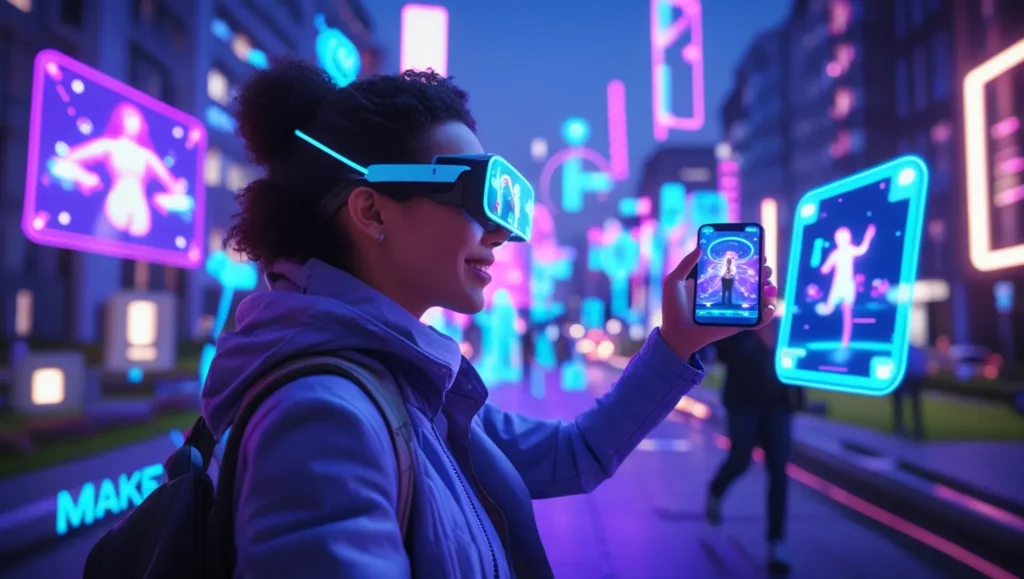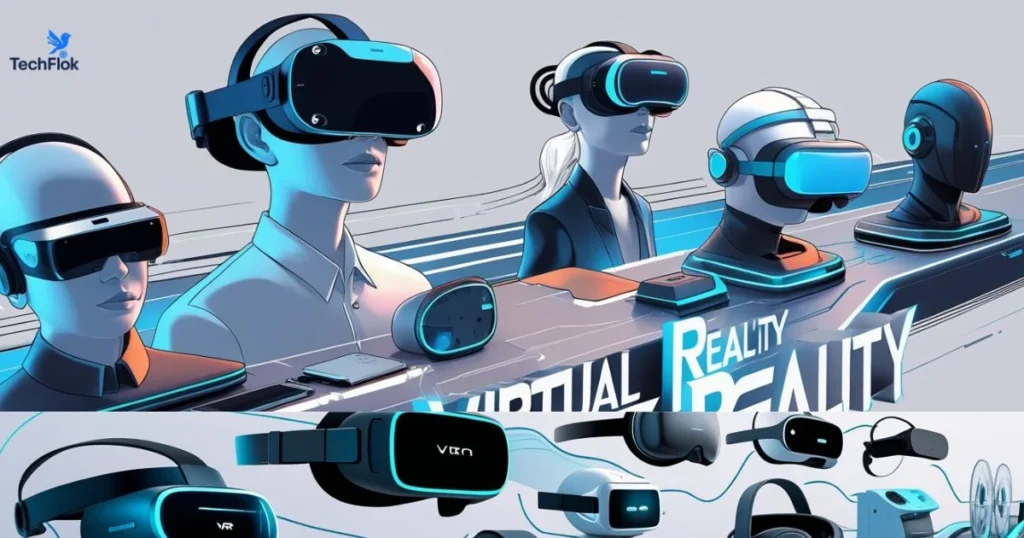
Virtual Reality is a technology designed to trick someone’s brain into believing something is real, even when it isn’t. VR History goes back to 1830. Using headsets and sensory devices, VR places users inside lifelike digital worlds where they can see, hear, and sometimes even feel their surroundings.
A fictional spark came in 1935, but the actual history of Virtual Reality goes back to 1830. The first innovation came with the invention of Stereopsis. In 1938, Sir Charles Wheatstone explained About Stereopsis, and then Research started.
1838 The Birth of Stereopsis
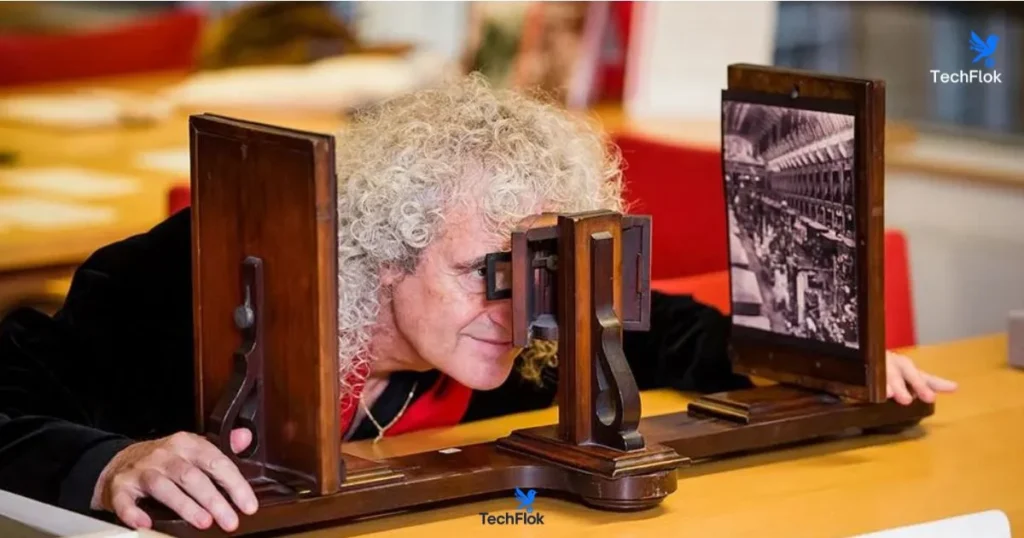
In 1838, Sir Charles Wheatstone became the first to explain Stereopsis. His Research showed that our brain can combine two slightly different images, one seen by each eye, to create a single image with depth. It was the beginning of 3D vision.
Wheatstone received the Royal Medal from the Royal Society in 1840 for his work.
The First Stereoscope
Using his discovery, Wheatstone built the first stereoscope.
It had two mirrors set at 45 degrees in front of the eyes, each reflecting a picture placed to the side.
This simple design created the illusion of a 3D image and set the stage for immersive visual technology.
1929 Link Trainer: The First Flight Simulator
In 1929, Edward Link built something groundbreaking the Link Trainer.
Patented in 1931, it is widely regarded as the world’s first commercial flight simulator.
The machine was completely electromechanical.
Motors connected to the rudder and steering column changed the pitch and roll, just like in a real aircraft.
A minor motor created bumps and shakes to mimic turbulence and in-flight disturbances.
Pilots needed safer training methods, and this invention was the answer.
The U.S. military quickly bought six Link Trainers for $3,500.
If you adjust for inflation, that’s almost $50,000 in 2015 money.
By the time World War II began, the ‘blue box’ Link Trainers filled training centers around the world.
More than 10,000 units were used to train over half a million pilots, providing essential instruction and helping them refine their skills.
Fictional Spark in 1935
In 1935, writer Stanley Weinbaum presented Pygmalion’s Spectacles, a visionary science fiction tale far ahead of its time. In the story, the protagonist dons a special pair of goggles. These goggles transport into a fictional world that engages all its senses and even includes holographic recordings.
Many believe this was the first big idea that hinted at what virtual Reality could one day become. It was a prediction of the VR achievements we have today.
Imagining Virtual Reality
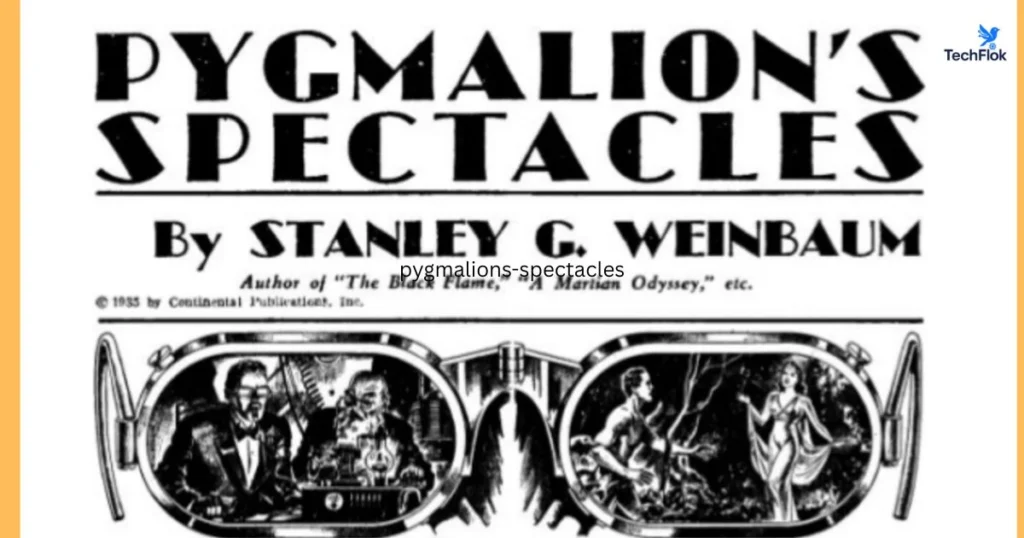
Almost a century later, in 1935, American science fiction writer Stanley Weinbaum took the idea further, this time into fiction.
In his short story Pygmalion’s Spectacles, the main character meets a professor who has invented a pair of goggles unlike anything seen before.
These goggles create a world you can see and hear.
You can taste, smell, and feel your surroundings. You’re not merely watching the story; you’re living inside it.
1956 The Sensorama Experience

In 1956, cinematographer Morton Heilig built something remarkable: the Sensorama, often considered the first VR machine.
It was patented in 1962 and looked like a large booth holding up to four people.
The Sensorama engaged all the senses.
It played full-colour 3D video with stereo sound.
It added vibrations, scents, and even wind to make the experience feel real.
Scent producers, a vibrating chair, stereo speakers, and a stereoscopic 3D screen all worked together to create the effect.
Heilig called it the “cinema of the future.”
He imagined people being wholly immersed in their films.
To demonstrate its capabilities, he produced six short films specifically for the Sensorama. These included:
- Motorcycle
- Belly Dancer
- Dune Buggy
- Helicopter
- A Date with Sabina
- I’m a Coca-Cola Bottle
1960 Birth of the First VR Head-Mounted Display
1960 marked a historic technological leap when filmmaker and inventor Morton Heilig created the first-ever VR Head-Mounted Display (HMD). Known as the Telesphere Mask, this pioneering device brought the concept of virtual immersion closer to reality. It offered stereoscopic 3D visuals and a wide field of view, giving users a sensation of being surrounded by the scene.
Although it lacked motion tracking or interactive controls, the Telesphere Mask laid the foundation for today’s modern VR headsets. At that time, wearing a device that could transport you into another world was revolutionary. This invention proved that the fusion of optics and imagination could reshape how humans experience media, setting the stage for decades of innovation in virtual reality technology.
1961 Pioneering the First Motion-Tracking VR Headset (Headsight)
In 1961, engineers Philco Corporation’s Comeau and Bryan introduced Headsight, a groundbreaking invention that became the world’s first motion-tracking head-mounted display. Unlike earlier headsets, Headsight integrated a magnetic motion tracking system, allowing the visual display to sync with the user’s head movements.
Initially designed for military and remote surveillance purposes, it featured small video screens inside the headset that displayed a live feed from an external camera. When the user turned their head, the camera remotely followed their motion, enabling real-time scene tracking from a distance.
Although Headsight wasn’t built for entertainment or virtual worlds, it was a monumental step in VR history. Its combination of visual immersion and head tracking proved that interactive, responsive environments were possible, a concept that would later become the backbone of modern virtual reality.
1965 Ivan Sutherland’s Vision of The Ultimate Display
In 1965, computer scientist Ivan Sutherland introduced a concept that would inspire decades of virtual reality development: The Ultimate Display. Instead of unveiling a physical device, Sutherland presented a visionary idea of a computer-controlled environment so realistic that it could simulate physical matter itself.
For a practical purpose, Suther imagined a room where a computer could create objects you could see, touch, and interact with. A chair good enough to sit in, handcuffs strong sufficient to restrain you, and even a virtual bullet that could be fatal. This radical vision redefined what technology could achieve, shifting VR from just visual simulation to full sensory immersion.
Though purely theoretical then, Sutherland’s Ultimate Display became a guiding principle for VR researchers. It planted the seed for technologies like haptic feedback, realistic physics engines, and true interactive worlds, proving that the limits of virtual reality were bound only by human imagination.
This concept became a blueprint for virtual Reality as we know it today.
1966 Thomas Furness and the Birth of the Flight Simulator
In 1966, Thomas Furness, an engineer with the U.S. Air Force, began developing a groundbreaking flight simulation system that would change pilot training forever. This early simulator wasn’t just about visuals; it aimed to replicate the sensory and situational experience of flying a real aircraft.
Furness designed a sophisticated cockpit environment that displayed instrument data, flight paths, and external views in real time, allowing pilots to practice without leaving the ground. His work laid the foundation for immersive military training technologies, combining computer-generated imagery with interactive controls to create a realistic and safe learning platform.
This project marked a key moment in VR history, showing that virtual environments could serve serious, high-stakes purposes beyond entertainment. Furness’s innovations would influence military and civilian simulation systems, earning him the nickname
“The Grandfather of Virtual Reality.”
1968 Sword of Damocles First True VR Headset
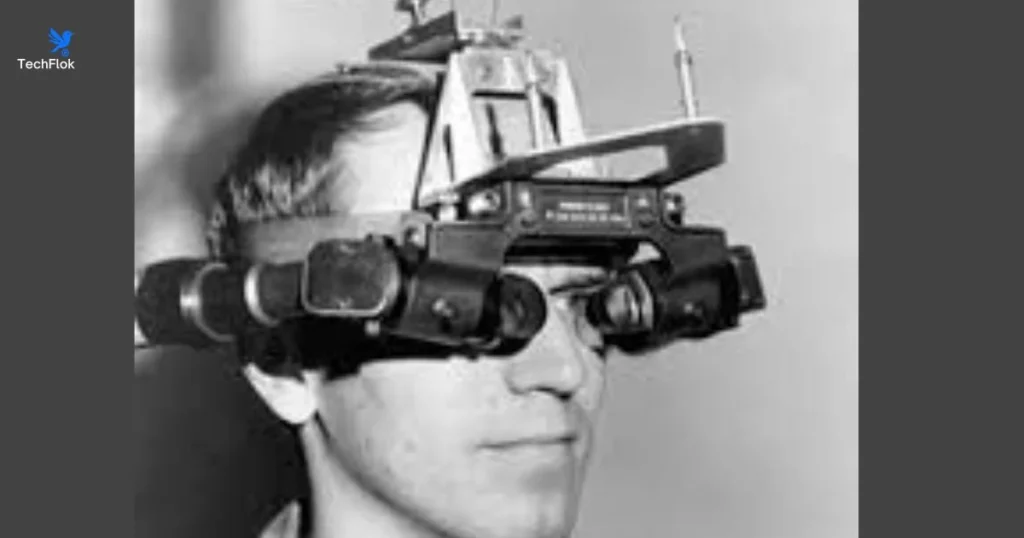
In 1968, Ivan Sutherland and his student Bob Sproull built the first VR/AR headset connected to a computer, not a camera.
It was called the Sword of Damocles.
The device was huge and intimidating.
It was so heavy it had to be suspended from the ceiling, and the user had to be strapped in.
The graphics were extremely basic, wireframe shapes and rooms, but this was a significant leap toward interactive virtual worlds.
1969 The Dawn of Artificial Reality
In 1969, computer artist Myron Krueger began shaping the concept of Artificial Reality. He envisioned interactive environments where technology would respond to a person’s movements and gestures. His early projects, GLOWFLOW, METAPLAY, and PSYCHIC SPACE, pushed the boundaries of interactive art and showed how computers could become active participants in human creativity.
This work eventually led to the creation of VIDEOPLACE. This system allowed people miles apart to communicate in a computer-generated environment that responded to their actions in real time. Krueger’s innovations transformed how humans could connect through technology, laying the groundwork for today’s gesture-based interaction and immersive communication platforms.
1972 Flight Simulation into the Digital Age
In 1972, General Electric took flight training to a new level by building one of the first digital flight simulators. That was a significant shift from earlier mechanical or analog systems. The new simulator used computer-generated graphics to create a more realistic training experience for pilots.
Trainees could see changing landscapes, runway approaches, and weather conditions controlled by a digital system. It allowed instructors to create different scenarios and repeat them as needed. GE’s work proved that digital technology could make simulations more flexible and lifelike. It became an essential step toward the high-tech flight simulators we see today.
1975 VIDEOPLACE: A New Era of Interactive Reality
In 1975, Myron Krueger introduced VIDEOPLACE, a groundbreaking interactive system that turned his vision of Artificial Reality into something people could experience firsthand. The technology allowed participants to see their silhouettes projected into a computer-generated world. They could move, gesture, or interact with shapes, and the system would respond instantly.
One of VIDEOPLACE’s most remarkable features was its ability to connect people in different locations. Two participants miles apart could appear together in the same virtual environment and interact as if they were side by side. It was an early look at how computers could connect humans creatively, responsively, long before the internet became mainstream.
1977 The MIT Movie Map Brings Cities to Screens
In 1977, researchers at MIT developed the Movie Map, an innovative project that let users explore a city without leaving the room. The team filmed every street in Aspen, Colorado, during different seasons and stored the footage in a computer system.
Users could navigate the streets using a touch interface, choosing which direction to go as if driving virtually. The system even allowed them to switch between summer and winter views. This project was an early form of virtual tourism and street navigation. It showed how technology could recreate real-world locations and allow people to explore them interactively. It is a concept that paved the way for tools like Google Street View, which emerged decades later.
1979 McDonnell-Douglas Brings Military-Grade HMD to Life
In 1979, McDonnell-Douglas introduced a new head-mounted display designed primarily for military and aviation training. This device gave pilots real-time flight data and targeting information directly in their line of sight. By projecting the information onto a transparent visor, pilots could keep their focus on flying while still accessing critical details.
The system also included motion tracking, so the displayed information adjusted as the pilot moved their head. This technology improved situational awareness and reaction speed in high-pressure situations. McDonnell-Douglas’ work in this era showed how VR-related hardware could move beyond research labs and become a practical tool in demanding, real-world environments.
1982 Sayre Gloves: A Breakthrough in VR Hand Tracking
In 1982, researchers Daniel J. Sandin, Thomas DeFanti, and Richard Sayre developed the Sayre Gloves, one of the first devices to let users interact with virtual environments using their hands. The gloves used optical sensors and light-emitting diodes to track finger movements with impressive accuracy for the time.
When users moved their fingers or made gestures, the system instantly translated those actions into the virtual world. That opened the door to more natural and intuitive interaction in VR. The Sayre Gloves became a stepping stone for later innovations like the Data Glove, proving that the sense of touch and motion could be just as important as sight in creating immersive experiences.
1985 Birth of VPL Research: A New Era in VR
In 1985, Jaron Lanier founded VPL Research, one of the first companies dedicated entirely to developing and selling virtual reality products. Lanier, a computer scientist and visionary, believed VR could become a powerful tool for communication, creativity, and exploration.
VPL Research went on to create some of the most influential early VR hardware, including the Data Glove, Eyephone headset, and full-body tracking systems. These products enabled users to see, move, and interact within computer-generated worlds in ways that had never been possible before. The company’s work helped shape the commercial VR industry and made “virtual reality” a widely recognized term.
1986 Evolution of the Super Cockpit
In 1986, Thomas Furness introduced the Super Cockpit, an advanced flight simulator designed for military pilots. Using a head-mounted display, this system displayed 3D maps, radar data, and flight information directly in front of the pilot’s eyes. It even allowed voice commands and hand gestures for control.
The Super Cockpit gave pilots instant access to complex information without looking away from their surroundings. This improved reaction times and situational awareness in high-speed missions. Furness’s invention showed how immersive technology could enhance real-world performance, influencing modern aviation systems and future VR interface designs.
1987 Virtual Reality Gets Its Official Name
In 1987, “Virtual Reality” gained widespread recognition thanks to Jaron Lanier, a visionary computer scientist and founder of VPL Research. Lanier used this phrase to describe immersive, computer-generated worlds where users could interact naturally with digital environments.
Before this, VR technology lacked a clear identity. Naming it “Virtual Reality” helped unify researchers, developers, and the public around a shared vision. VPL Research became one of the first companies to create VR hardware and software, including innovative products like the Data Glove and early head-mounted displays.
It was also a huge step forward for VR haptics, as VPL’s devices enabled users to feel and manipulate virtual objects through touch. This milestone laid the foundation for the VR industry, inspiring innovations and pushing the boundaries of how people connect with digital worlds.
1989 NASA Launches Project VIEW: Pioneering VR for Astronaut Training
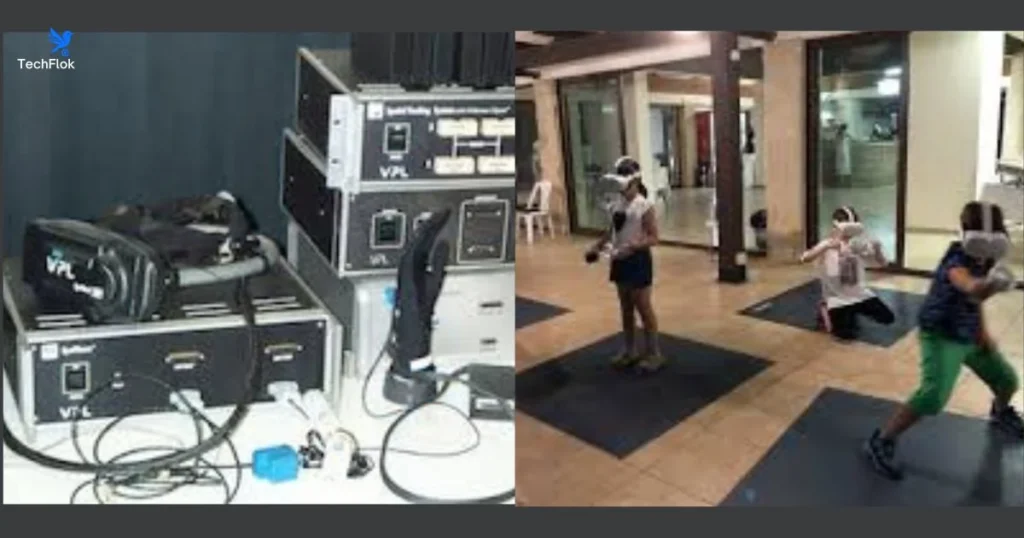
In 1989, NASA teamed up with Crystal River Engineering to create Project VIEW, a cutting-edge virtual reality simulator for astronaut training. This VR system lets astronauts explore virtual spacecraft interiors and practice mission tasks in a safe, controlled environment.
Project VIEW went beyond visuals by including special gloves that allowed fine-touch interaction. These gloves helped astronauts precisely manipulate virtual objects and inspired later consumer technologies, such as the Nintendo Power Glove.
NASA’s collaboration on Project VIEW marked a massive step in applying virtual reality to serious, high-stakes training. It showed how VR could improve safety, skill, and mission success while driving innovation that would reach far beyond space exploration.
1991 Virtuality Group Brings VR to the Arcade
In 1991, Virtuality Group introduced some of the first virtual reality arcade machines to the public. These machines offered immersive 3D gaming experiences that allowed players to explore virtual worlds through head-mounted displays and joystick controls.
Virtuality’s arcade systems featured real-time graphics and motion tracking, making the gameplay feel fresh and exciting. It was their first encounter with VR technology outside of research labs and military use for many people.
Though limited by the technology of the time, these VR arcades laid the groundwork for the future of immersive gaming and showed the public the thrilling possibilities of virtual reality.
1991 Medina’s VR Mars Rover
That same year, NASA engineer Antonio Medina was working on a very different VR challenge, controlling a Mars rover from Earth.
He developed a system called Computer Simulated Teleoperation that accounted for the long signal delay between planets.
For the early ’90s, this was an incredible leap forward, and it paved the way for the type of rover operations we take for granted today.
1992 VR to Movies
In 1992, Hollywood introduced the world to virtual reality with the movie The Lawnmower Man. The film showcased VR as a thrilling and futuristic technology, capturing the imagination of audiences worldwide.
The movie explored how VR could transform learning, communication, and even human intelligence, though in a highly fictionalized way.
Despite its dramatization, it popularized the concept of virtual reality and inspired interest in VR technology beyond laboratories and arcades.
It introduced virtual Reality to a much wider audience and was partly inspired by VR pioneer Jaron Lanier and his early lab work.
Pierce Brosnan played a scientist using VR therapy on a patient, and the production even used real VPL Research VR equipment.
Director Brett Leonard later admitted that companies like VPL heavily influenced the film’s vision of VR.
1993 SEGA’s VR Glasses
In 1993, Sega captured attention at the Consumer Electronics Show by unveiling the Sega VR headset for its Genesis console. The headset featured sleek wrap-around glasses with head tracking, stereo sound, and tiny LCD screens inside the visor. Sega even developed four games to showcase the technology.
The headset was priced around $200, roughly $322 in 2015. However, technical issues and hardware limitations kept the device from reaching the market. Although it never launched, Sega’s VR glasses became a legendary prototype, remembered as one of the company’s most ambitious and imaginative projects. It inspired future VR development and showed the possibilities of bringing immersive gaming into homes.
1994 Sega VR-1
Sega couldn’t resist pushing VR forward in the ’90s. In 1994, they launched the Sega VR-1, an arcade motion simulator that didn’t just let you see the game, it moved with it.
Think of it as their earlier AS-1 machine, but this time with a head-mounted display instead of a projection screen. The result? Players felt like they were truly inside the action.
1995 Nintendo Virtual Boy
In 1995, Nintendo promised to bring 3D gaming into your hands with the Virtual Boy also known as the VR-32.
It was marketed as the first portable console to show “true” 3D graphics, launched in Japan and North America for $180.
Unfortunately, it flopped hard. The graphics were only in red and black, there weren’t many games, and the awkward design made it uncomfortable to play. Even price drops couldn’t save it, and by the following year, Nintendo pulled the plug.
1997 Virtual Reality Enters PTSD Treatment
In 1997, researchers began exploring virtual reality as a tool to help treat PTSD. VR allowed therapists to create controlled, immersive environments where patients could safely confront and process traumatic memories.
The technology made exposure therapy more effective by letting patients experience situations in a gradual and guided way. For example, veterans could revisit combat scenarios in a virtual space while remaining safe and supported. Using VR in PTSD treatment marked a significant step forward for mental health care, showing that immersive technology could have meaningful, real-world therapeutic applications beyond gaming and entertainment.
1999 Matrix Changes the Game
In 1999, the Wachowski siblings released The Matrix, a movie that made millions of people question Reality itself. In the film, humans live in a fully simulated world, most of them completely unaware it’s not real.
Sure, earlier films like Tron (1982) and The Lawnmower Man (1992) had touched on virtual Reality, but The Matrix brought the concept of simulated worlds into the cultural spotlight in a way nothing else had.
2007 Street View
Google took its Maps service to a new level with Street View 360-degree images captured by special cars fitted with custom cameras.
The work was done by Immersive Media, using a dodecahedral camera of their design. Suddenly, you could “stand” in nearly any city and look around without leaving home.
2010 A New Era: 3D Street View and Oculus Rift
In 2010, Google Street View took a significant leap forward by introducing 3D mapping, allowing users to explore cities with greater depth and realism. This innovation made virtual navigation feel more immersive and interactive than ever before.
At the same time, Palmer Luckey began developing the prototype of the Oculus Rift, a VR headset that would soon redefine immersive gaming and virtual reality experiences. The Rift offered wide field-of-view visuals, precise motion tracking, and an affordable approach to bringing high-quality VR to consumers.
These breakthroughs marked a turning point for virtual reality. 3D Street View showed how real-world environments could be digitized, while Oculus Rift reignited excitement for VR in homes, sparking the modern wave of consumer and gaming VR we know today.
2012 Oculus Rift Takes Off on Kickstarter
In 2012, Palmer Luckey launched a Kickstarter campaign for the Oculus Rift, a VR headset designed to bring high-quality virtual reality to consumers. The campaign quickly gained attention, raising almost $2.5 million from backers worldwide, far exceeding its original goal of $250,000.
The success of the Kickstarter proved strong demand for affordable, immersive VR experiences. It also inspired other developers and companies to invest in VR hardware and software. The campaign marked a significant turning point, signaling the start of the modern VR era and showing that virtual reality could capture the imagination of both gamers and technology enthusiasts alike.
2014 Facebook Buys Oculus, Sony Joins VR Race
In 2014, Facebook acquired Oculus VR for $2 billion, signaling a significant shift in the virtual reality industry. The acquisition showed that VR had moved beyond niche gaming into mainstream technology with massive commercial potential.
At the same time, Sony entered the VR market, announcing the Project Morpheus, later renamed PlayStation VR, to bring immersive experiences to console gamers. These moves intensified competition, spurring hardware, software, and content innovation. By combining corporate investment with consumer-ready devices, 2014 marked the beginning of VR’s modern era, paving the way for widespread adoption and exciting new applications.
2016–2017 VR Hits the Spotlight
Between 2016 and 2017, virtual reality experienced a significant boom as consumer VR devices hit the market. The Oculus Rift launched in March 2016, followed by the HTC Vive in April 2016, offering full-room tracking and immersive experiences for home users. PlayStation VR joined the market in October 2016, bringing VR to millions of console gamers.
By the end of 2016, industry analysts estimated that over 2 million VR headsets had been sold worldwide, and VR game sales exceeded $200 million. Investment in VR startups also surged, with over $1 billion poured into VR and AR companies in 2016 alone.
This period marked the first time virtual reality moved beyond prototypes and arcades into mainstream entertainment, gaming, and education, setting the stage for rapid innovation in hardware, software, and content.
2018 Standalone VR Emerges with Half-Dome
Oculus revealed a cutting-edge prototype called the Half-Dome, featuring varifocal lenses and a massive 140-degree field of view.
It was also the year of Oculus Go and Oculus Quest, standalone headsets that didn’t need a PC or phone. At the same time, mobile VR was fading fast.
2019 VR Transforms into Mixed Reality
By 2019, virtual reality had begun evolving into mixed reality (MR), blending digital objects with the real world. Companies like Microsoft led this shift with devices like the HoloLens 2, offering improved field of view, hand tracking, and spatial mapping.
Mixed reality found applications beyond gaming, including training, architecture, and remote collaboration. For instance, MR in enterprise training reduced errors and improved efficiency, with companies reporting up to 30% faster skill acquisition in VR/MR environments. The global AR/VR market grew to an estimated $18.8 billion in 2019, with mixed reality contributing significantly to this expansion.
This evolution marked a key milestone, showing that immersive technology could integrate seamlessly with real-world tasks, paving the way for enterprise, education, and industrial adoption.
Conclusion
The VR History reflects humanity’s drive to create, explore, and immerse itself in new worlds. From the panoramic paintings of the 1800s to today’s advanced mixed reality headsets, each breakthrough has expanded what’s possible in digital experiences. Over time, virtual Reality has grown from an artistic illusion into a powerful gaming, training, therapy, and education tool. It has redefined how we connect, learn, and interact with information.
As technology advances, VR becomes more realistic, intuitive, and widely available, moving closer to the vision of fully interactive, lifelike digital worlds. The past two centuries have laid a strong foundation, but the most exciting chapters of VR History are still ahead. With every innovation, the boundary between the physical and virtual continues to fade, opening limitless possibilities for the future of human experience.
FAQs
What is the history of VR?
The history of VR spans over 200 years, starting with panoramic paintings in the early 1800s, evolving through stereoscopes, flight simulators, and experimental headsets in the mid-20th century, before becoming computer-driven in the 1960s. It entered public awareness in the 1990s through arcade machines and gaming, and became mainstream after 2016 with affordable consumer headsets.
When did VR come out?
The first computer-based VR headset, the “Sword of Damocles,” appeared in 1968, but consumer VR became available in the 1990s and was widely accessible after 2016.
Who is the father of virtual Reality?
Jaron Lanier is often called the father of virtual Reality for popularizing the term and pioneering commercial VR in the 1980s.
Was VR a thing in the 90s?
Yes. The 1990s saw VR arcades, Sega VR prototypes, and the Nintendo Virtual Boy. It was limited by low graphics quality and high costs.
When was VR invented?
The concept began in the 1800s, but the first actual VR headset linked to a computer was invented in 1968 by Ivan Sutherland and Bob Sproull.
What is the history of virtual Reality?
It began with visual illusions in the 19th century, advanced through simulators and experimental headsets in the 20th century. It now includes immersive 3D worlds, motion tracking, and mixed reality experiences in the 21st century.
Who invented VR gaming?
While no single person invented VR gaming, Virtuality Group popularized it in 1991 with multiplayer arcade VR machines.
What was VR originally used for?
Before being adapted for Research, industry, and entertainment, early VR-like technology was used for military training, particularly in flight simulators.


